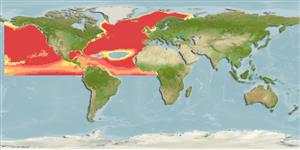Actinoptérygiens (poissons à nageoires rayonnées) >
Lophiiformes (Anglerfishes) >
Thaumatichthyidae (Wolftrap anglers (Ref. 7463), Wolftrap Seadevils (Ref. 86949))
Etymology: Lasiognathus: Greek, 'lasios' = hairy or wooly + Greek, 'gnathos' = jaw (with reference to the huge number of long teeth of the upper jaw) ( Ref. 86949).. More on author: Regan, Trewavas.
Environnement / Climat / Gamme
Écologie
; marin bathypélagique; profondeur 0 - 1100 m (Ref. 27827). Deep-water, preferred ?
Eastern Central Pacific: Hawaii. Atlantic Ocean: Madeira and Bermuda.
Taille / Poids / Âge
Maturity: Lm ? range ? - ? cm
Max length : 11.5 cm TL (female)
Description synthétique
Morphologie | Morphométrie
Rayons mous dorsaux (Total): 6-7; Rayons mous anaux: 4 - 5. Escal bulb without membranous anterior crest. Distal escal appendage compressed, transversely fan-shaped, bearing three bony escal hooks along posterior margin, without elongate prolongation emerging from bases of escal hooks. Posterior escal appendage cylindrical, tapering to a point (Ref 27827). Length of illicium 43-44%SL in small specimens, 47-50%SL in large specimens (8 to 11.2 cm); posterior escal appendage 0.5-2.5%SL, emerging from below escal pore; thin edge of distal appendage behind and between bases of escal hooks more or less folded; length of distal appendage, measured from surface of escal bulb to bases of escal hooks, 1.3-2.8% SL (Ref. 86949).
A piscivore, feeding occasionally on invertebrates (Ref. 27828).
Life cycle and mating behavior
Maturité | Reproduction | Frai | Œufs | Fécondité | Larves
Bertelsen, E. and T.W. Pietsch, 1996. Revision of the ceratioid anglerfish genus Lasiognathus (Lophiiformes: Thaumatichthyidae), with the description of a new species. Copeia 1996(2):401-409. (Ref. 27827)
Statut dans la liste rouge de l'IUCN (Ref. 115185)
CITES (Ref. 94142)
Not Evaluated
Menace pour l'homme
Harmless
Utilisations par l'homme
Plus d'informations
Noms communsSynonymesMétabolismePrédateursÉcotoxicologieReproductionMaturitéFraiFéconditéŒufsDéveloppement de l'œuf
Taille/ÂgeCroissanceLongueur-poidsLongueur-longueurFréquences de longueursMorphométrieMorphologieLarvesDynamique des populations larvairesRecrutementAbondance
RéférencesAquacultureProfil d'aquacultureSouchesGénétiqueFréquences alléliquesHéritabilitéPathologiesTraitementMass conversion
CollaborateursImagesStamps, CoinsSonsCiguateraVitesseType de nageSurface branchialeOtolithesCerveauxVision
Outils
Articles particuliers
Télécharger en XML
Sources Internet
Estimates of some properties based on models
Phylogenetic diversity index (Ref.
82805): PD
50 = 0.5352 [Uniqueness, from 0.5 = low to 2.0 = high].
Bayesian length-weight: a=0.01995 (0.00906 - 0.04395), b=3.01 (2.83 - 3.19), in cm Total Length, based on all LWR estimates for this body shape (Ref.
93245).
Niveau trophique (Ref.
69278): 4.0 ±0.63 se; Based on food items.
Résilience (Ref.
69278): .
Vulnérabilité (Ref.
59153): Low vulnerability (10 of 100) .
